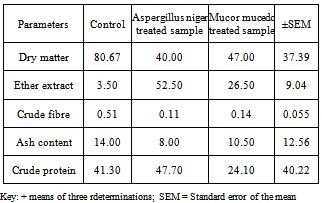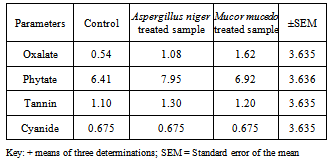-
Paper Information
- Next Paper
- Previous Paper
- Paper Submission
-
Journal Information
- About This Journal
- Editorial Board
- Current Issue
- Archive
- Author Guidelines
- Contact Us
American Journal of Chemistry
p-ISSN: 2165-8749 e-ISSN: 2165-8781
2012; 2(3): 112-114
doi: 10.5923/j.chemistry.20120203.02
Toxicity and Antimetabolic Properties of Biologically Treated Neem Seed (Azadiracta indica) Kernel Cake
Mubarak O. Ameen1, Moshood A.Belewu2, Lamidi A.Usman1, Oladoyin O.Onifade1, Sophia O. Adetutu1
1Department of Chemistry, University of Ilorin, Ilorin, 240001, Nigeria
2Department of Animal Production, Microbial Biotechnology and Dairy Science Laboratory, University of Ilorin, Ilorin, 240001, Nigeria
Correspondence to: Mubarak O. Ameen, Department of Chemistry, University of Ilorin, Ilorin, 240001, Nigeria.
| Email: |  |
Copyright © 2012 Scientific & Academic Publishing. All Rights Reserved.
Seeds from Neem plants were ground and defatted to obtain the meal, the neem seed cake (NSC). The seed cake was fermented with two different fungi Aspergillus niger and Mucor mucedo. Proximate compositions as well as antinutrient factor of the treated cakes were analyzed. The results obtained reveals that the defatted Neem seed cake treated with A. niger contains protein of 47.70% which is higher than the seed cake treated with M. mucedo and the untreated sample. The untreated sample which is the control contains more dry matter and crude fiber of 80.67% and 0.51% respectively. It was also observed that the sample treated with A. niger contains more phytate and tannin of 7.95% and 1.30% respectively. Though the treatment has increased the crude protein content of Neem seed cake, but the biological treatment may not be suitable for the detoxification of neem seed cake as the antinutrient factors (oxalate, phytate, tannin and cyanide) determined were significantly higher in the treated than the untreated seed cake.
Keywords: Neem Seed Cake, Aspergilus Niger, Mucor Mucedo, Antinutrients
Article Outline
1. Introduction
- Several attempts have been made to find solutions to nutritional problems in Africa in relation to protein intake. Interest in newer sources of protein has grown due to protein shortage in developing countries, especially Nigeria. As part of the quest for newer sources, some lesser-known oil seeds have been evaluated for their nutritional qualities in India[1-5]. In Nigeria, locally available but unusual proteins containing foodstuffs have been evaluated for their nutritional potentials, aiming at reducing dependence and competition between livestock and man for the consumable sources[6–8].Neem (Azadirachta indica), is an evergreen tree which is endemic to the Indian subcontinent and has been introduced to many other areas in the tropics[9]. The tree is known to cure more than one hundred diseases. Neem seed cake (NSC) is a by-product showing great potential for livestock feeding[10,11], NSC meal is a protein rich source (CP: 34-38%), the protein in the cake is relatively balanced in its amino acid and mineral profiles[12,13].Despite the high nutritional value of NSC especially for livestock, its bitter taste and foul odour limits its use as a food source,[14]. The bitter taste of neem seed is as a resultof the presence of sulphur containing compounds, while the tignic acid is the main compound believed to be responsible for its odour,[15,16]. Consequently, the cake has been treated by various methods, including water washing[11], urea treatment[10] and solvent treatment[17-19]. Similarly, Regional Research Laboratory, Hyderabad in India has developed a simple extraction process of removing toxic compounds. When Udayashekara employed this process on neem seed, the seed was devoid of the bitter taste and its usual foul smell while retaining its nutritional value[14]. In another work Usman et al has attempted the extraction of protein from the neem seed[20]. This work thus aims at studying the effects of biological treatment (Aspergillus niger and Mucor mucedo) to inactivate the antinutrional factors in Neem Seed Cake.
2. Experimental
2.1. Preparation of Neem Seed Cake
- The seeds were obtained from ripe fruits harvested from different locations in Ilorin, Nigeria. The exocarp and pulp of the riped fruit was removed and the endocarp was oven dried at 60℃. The dried endocarp was cracked to obtain the seed. The seeds were milled using magic blender (SHB – 515 model made by Sorex Company Limited, Seoul Japan) to obtain the seed cake. Standard Official and Tentative Method of Association of Official AnalyticalChemists procedure was used to defat the seed cake[21]. The defatted seed cake was dried and kept for analysis. The cake was autoclaved using an autoclaving machine set at a temperature of 121℃ for 30 minutes in the laboratory of the Department of Biochemistry University of Ilorin, Ilorin.
2.2. Preparation and sub- culturing of the Fungi
- The fungi (Mucor mucedo and Aspergillus niger) were obtained from the laboratory of the Department of Microbiology, University of Ilorin, Ilorin.A paste of Potato Dextrose Agar (PDA) was prepared by weighing 10 g of PDA in 250 ml of distilled water; it was then autoclaved (Autoclave machine model YSQ-LS-/00SII) at 121℃ at 15 lbs per square inch for 15 minutes. It was allowed to cool to about 45℃ and streptomycin injection was added. The mixture was then poured into a sterile plate and allowed to set (solidify), after setting, the required organism was inoculated into the plate and incubated at room temperature for 72 hours. A pointed needle was used to pick the organism from the stock and stab the center of the plate.
2.3. Inoculation and Incubation of Neem Seedl cake
- The autoclaved cake was divided into three portions, a portion was inoculated with Aspergillus niger (treatment A) another Mucor mucedo (treatment B) while the third was left untreated (Control experiment). All the treatments were inoculated at ambient temperature in the laboratory. The fungal growth was terminated after 10 days by oven drying the spent substrates in an air draught oven at 70℃ for 24 hours in the laboratory of the Department of Animal Production, Faculty of Agriculture, University of Ilorin.
2.4. Analyses
- The proximate compositions of the fermented samples were analyzed using the method of AOAC[21]. All data were analyzed using ANOVA of a completely randomized design model.
3. Results and Discussions
- Neem seed cake can be a source of protein for animal feed if the cake is properly treated to remove the antinutritional principles in the seed. This work attempted the improvement of the nutritional quality of the neem seed cake using biological treatment method. Table 1 present the proximate composition of fungi treated and untreated neem seed cake.The results presented in Table 1 shows the effect of the biological treatment on the dry matter, ether extract, crude fibre, ash content and crude protein contents of neem seed cake. The results clearly indicate that the treatment reduces the dry matter, crude fibre and ash content of the neem seed cake, while the ether extract was drastically increased. There was on the other hand an increase in the crude protein of the A. niger but a decrease in the M. mucedo treated cakes, Table 1. These observations are similar to those of Belewu & Sam and Belewu M. A. who also treated Jatropha curcas kernel for nutritional improvement biologically[22-23].
|
|
4. Conclusions
- Various methods has been described for the treatment of neem seed cake so that it could be useful in animal feeds, this attempt at using biological treatment for the detoxification of neem seed cake was not successful as the antinutrional factors in the treated cakes were significantly higher than the untreated cake. Thus it can be concluded that A. niger and M. mucedo may not be suitable for the treatment of neem seed, however treatment with other types of fungi may give positive results or other treatments can be improved upon.
 Abstract
Abstract Reference
Reference Full-Text PDF
Full-Text PDF Full-Text HTML
Full-Text HTML
